Who Was Dorothy Parker?
 Dorothy Parker was compulsively funny and today she is known for many witticisms that have found themselves in our common parlance. I feel I’ve known her all my life. I was young I remember my father mirthfully quoting lines such as, “You can lead a horticulture, but you can’t make her think”; from Mad Magazine I once read that “Beauty is only skin deep but ugliness is to the bone”. I don’t recall my father ever mentioning Dorothy Parker although doubtless he knew who she was; Mad Magazine changed a few words but the quote’s basic meaning is the same as Parker’s original line. Later, in the days of my wayward youth with its excessive alcohol consumption, I appreciated the wisdom of “I’d rather have a bottle in front of me than a frontal lobotomy.” Then, later in life, it was “Living well is the best revenge.” I didn’t know these lines were also penned by her.
Dorothy Parker was compulsively funny and today she is known for many witticisms that have found themselves in our common parlance. I feel I’ve known her all my life. I was young I remember my father mirthfully quoting lines such as, “You can lead a horticulture, but you can’t make her think”; from Mad Magazine I once read that “Beauty is only skin deep but ugliness is to the bone”. I don’t recall my father ever mentioning Dorothy Parker although doubtless he knew who she was; Mad Magazine changed a few words but the quote’s basic meaning is the same as Parker’s original line. Later, in the days of my wayward youth with its excessive alcohol consumption, I appreciated the wisdom of “I’d rather have a bottle in front of me than a frontal lobotomy.” Then, later in life, it was “Living well is the best revenge.” I didn’t know these lines were also penned by her.
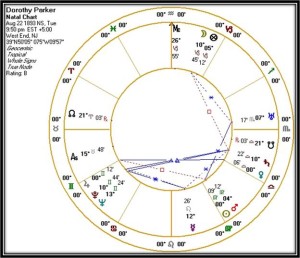 There is much to say about her rich and troubled life. If you are interested in learning more about Parker, I would suggest Marion Meade’s wonderful biography Dorothy Parker: What Fresh Hell Is This? It discloses much of the delightf and melancholic complexity of this woman.
There is much to say about her rich and troubled life. If you are interested in learning more about Parker, I would suggest Marion Meade’s wonderful biography Dorothy Parker: What Fresh Hell Is This? It discloses much of the delightf and melancholic complexity of this woman.
(On the right is her astrology chart: click to see a larger image.)
Parker was born in 1893 of an upper-class household in New York. Her father’s side of the family had been in the apparel manufacturing business for decades and they were quite well off. Dorothy’s mother died when she was five; her father’s second wife died when Dorothy was nine. After finishing school (she never went to college), and after her father died in 1913, she worked part time but got her first poem published by Vanity Fair. Her literary career began with a job as a proof-reader for Vogue and a few years later she went to Vanity Fair to be their drama critic.
Parker, with Algonquin Round Table members and guests (l–r) Art Samuels (editor of Harper’s and, briefly, The New Yorker), Charles MacArthur, Harpo Marx, and Alexander Woollcott
Lucky for Parker and many others, this was the beginning of a golden age for New York literary magazines. She became widely known as a regular member of the Algonquin Round Table, named after the large table in the dining room at the Algonquin Hotel where she and other literary people broke for lunch. Some of the participants wrote down their conversations; depicting Parker’s spontaneous wit quickly made her famous within literary circles and, soon enough, nationally. (The Algonquin Hotel is still there on 44th St. in Manhattan and has been designated as a New York historical monument.)
Parker’s New York career saw the publication of many poems, some included in the best-seller Enough Rope that was published in 1926. She continued to write theatre and later book reviews that ranged from the desultory to the humorous to the scathing. Early in her career her blustery reviews got her fired from Vanity Fair; later she was to get a job working for a startup magazine called the New Yorker and wrote for them for decades, contributing poems, stories, and a review column. Her most famous short story was “Big Blonde” that is largely autobiographical (Parker but with a larger physical frame and without the talent), a compelling read, and emotionally wrenching.
 In 1927 Parker became “radicalized” when she became involved with the protests over the immanent execution of Sacco and Vanzetti. From that time on she associated herself with liberal causes, from the Spanish Civil War to raising money for the Scottsboro boys to an active involvement in the Civil Rights movement. Although continuing her lifestyle among literary and privileged, she developed a strong ambivalence towards the many well-heeled people with whom she associated.
In 1927 Parker became “radicalized” when she became involved with the protests over the immanent execution of Sacco and Vanzetti. From that time on she associated herself with liberal causes, from the Spanish Civil War to raising money for the Scottsboro boys to an active involvement in the Civil Rights movement. Although continuing her lifestyle among literary and privileged, she developed a strong ambivalence towards the many well-heeled people with whom she associated.
She had three marriages and two husbands. She married Edwin Parker as a young woman, took his name, but their marriage dissolved after eleven years. She married Alan Campbell in 1934, they divorced but remarried a couple of years later. Her marriage to Campbell, a Hollywood actor and aspiring screenwriter, brought Parker to Hollywood twice and resulted in her having a hand in many screenplays including “A Star is Born”. In the early 1950s during the McCarthy Era she was blacklisted from work in Hollywood, returned to New York but came back to Hollywood later for a few years.
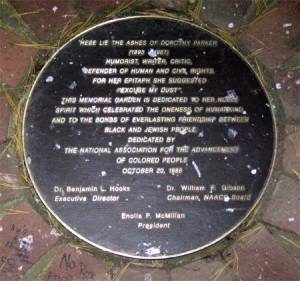 After Campbell’s suicide Parker returned to New York where she lived the rest of her life. Her estate first went to Martin Luther King and after King’s death to the NAACP, where her remains are contained near their headquarters in Baltimore. The epitaph she proposed, duly recorded on her memorial plaque, embodies her elegant earthiness: “Excuse my dust.”
After Campbell’s suicide Parker returned to New York where she lived the rest of her life. Her estate first went to Martin Luther King and after King’s death to the NAACP, where her remains are contained near their headquarters in Baltimore. The epitaph she proposed, duly recorded on her memorial plaque, embodies her elegant earthiness: “Excuse my dust.”
Sexual adventures, alcohol abuse, and fascination with suicide are also part of her biography. Between and during her marriages Parker had numerous affairs, a few times had fallen in love disastrously, sometimes had an active casual sex life (if you believe her writing), and had at least one abortion followed by a suicide attempt. She was equally famous for her alcohol consumption and her ability to write humorously about it. We see her fascination with suicide in the title of her book of poetry Enough Rope, and with her most famous poem I’ll provide below. For all her seeming success in life, Parker has a lion’s share of self-deprecating and self-destructive behavior.
Parker’s Astrology: What Do We Want to Know?
Given all this, what would an astrologer ask of her chart? One would look for indicators of her unique literary and epigrammatic genius. One would also look for her political transformation and subsequent life as an activist, also her penchant for sexual expressiveness, alcohol excess, and self-destruction in general. Parker’s birth chart is a thing of beauty and rewards close attention to these and other issues.
Mercury and Its Environs
When considering Parker’s famous wit and intellectual incisiveness we must begin with Mercury that is in Leo in her natal chart. We notice that it is the only visible planet that is angular in her chart. Mercury has aspects from all three outer planets: sextiles from Pluto and Neptune in Gemini and a square from Uranus. Mercury keeps pretty heavy company! Although more distant in orb, the square from Uranus is the most important of the three, because (1) a square denotes dynamic tension, and (2) Uranus is also in an angular house, the Seventh House of relationships. Part of who she was included romantic restlessness and a desire and ability to shock others. According to Meade’s biography, Parker trained herself in a lofty intellectual accent that she routinely peppered with profanity.
To finish the roll-call of planets with whom her Mercury connects, we also note the sextile to Saturn in its exaltation but in the sixth house. This helped give her language a discipline and brevity that contributed to her talents as a writer and as a very witty conversationalist. We will say more about Saturn below.
 Mercury had gone direct only a few days before Dorothy Parker was born, was slow of motion and gradually building distance from the Sun before it speeds up. Mercury being oriental (and visible) would enhance its effectiveness. However, many ancient astrologers would consider Mercury “out of sect” since it is ahead of the Sun in a nocturnal chart, and is additionally on the same side of the horizon as the Sun and is in a masculine sign. Possibly if Dorothy Parker was born during the daytime with the same angular Mercury in sect, she might have been more cheerful, maybe less melancholy – but what fun would that have been?
Mercury had gone direct only a few days before Dorothy Parker was born, was slow of motion and gradually building distance from the Sun before it speeds up. Mercury being oriental (and visible) would enhance its effectiveness. However, many ancient astrologers would consider Mercury “out of sect” since it is ahead of the Sun in a nocturnal chart, and is additionally on the same side of the horizon as the Sun and is in a masculine sign. Possibly if Dorothy Parker was born during the daytime with the same angular Mercury in sect, she might have been more cheerful, maybe less melancholy – but what fun would that have been?
Mercury is also the dispositor for Sun and Mars who are conjunct in Virgo. Is there a mutual reception between Sun in Virgo and Mercury in Leo, since they’re in each others’ signs? I think not, since these signs are disconnected from each other there’s no environment that brings them into contact with each other. It’s like two burglars who have different numbers of a combination to a safe but they cannot locate each other and the safe stays locked. Put another way, the emotional expressiveness of Mercury in Leo is in the same room as the perfectionism and keen discriminating abilities of Sun in Virgo but they are not together. She never brought together her work as a creative artist and as a critic to produce the greater literary work of which she was capable but never quite accomplished.
 This disconnect is magnified when considering Parker’s Lots from the Hellenistic tradition. Looking at her chart rendered in this way, her lots of Victory, Exaltation, and the all-important Lot of Spirit are all in Virgo, all disconnected to their sign ruler Mercury. If one looks at Lot of Spirit as having its own set of twelve houses, the lord of the Lot of Spirit is in its Twelfth House. This provides another avenue into her self-destructiveness.
This disconnect is magnified when considering Parker’s Lots from the Hellenistic tradition. Looking at her chart rendered in this way, her lots of Victory, Exaltation, and the all-important Lot of Spirit are all in Virgo, all disconnected to their sign ruler Mercury. If one looks at Lot of Spirit as having its own set of twelve houses, the lord of the Lot of Spirit is in its Twelfth House. This provides another avenue into her self-destructiveness.
To discuss her political orientation we continue looking at Sun in Virgo and its aspects. The relationship between Sun and Mars is ambiguous – does Mars add its aggressiveness to her Virgo Sun or is Mars subsumed under the beams of the Sun, or is burnt by being combust? Traditions differ. No, she did not suffer fools gladly, even when she was the one being foolish, but Parker also had a generous giving nature. We will see below the strong role of Mars during her involvement with the controversy regarding Sacco and Vanzetti. It is clear to me that Mars, even within the Sun’s rays, has a strong presence in Parker’s chart.
Jupiter, the Great Benefic in Gemini, is oriental to the Sun and in square to Sun very closely, within three minutes. This would allow Parker to transcend her self-absorption and her inner demons through political and cultural involvement and everyday acts of personal kindness. Jupiter is in detriment in Gemini but this may have worked to her advantage. Since Gemini works in multiples, not unified concepts, this is not an ideological Jupiter. Jupiter could bring her a degree of empathy, especially for victims of discrimination and injustice. Together with Mars, Jupiter provided Parker ample support for liberal political outrage.
For those who use non-Ptolemaic aspects and especially for those who use harmonic charts, note the quintile (72°) between Jupiter at 0° Gemini and Mercury at 12° Leo, a relationship that bestows one talent with words and ideas. Additionally, Jupiter and Mercury are in trine to Venus her Fifth Harmonic chart, adding personal charisma to literary and political expression.
Sex, Alcohol, and Self-Destructiveness
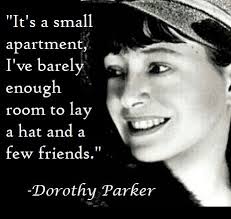 This brings us to her exuberant sexuality that was fashionable in the “Roaring Twenties” but less fashionable during the Depression and afterwards. The planet most involved is Venus in Libra that, if well placed in the chart, is adept at the interaction and exchange that goes along with sexual behavior. Jupiter in Gemini, in exact trine to Venus, brings possibility if not steadiness in love. Venus is the ruler of Parker’s Ascendant in Taurus but is stuck in the Sixth House unrelated to the place of the Ascendant: this placement may undo happiness or personal gain from an otherwise positive planetary combination. Although the Sixth Place is a hidden place there was nothing hidden about Parker’s sexuality or romantic life, yet these endeavors afforded her little happiness but instead provided a window onto some of the miseries of human life.
This brings us to her exuberant sexuality that was fashionable in the “Roaring Twenties” but less fashionable during the Depression and afterwards. The planet most involved is Venus in Libra that, if well placed in the chart, is adept at the interaction and exchange that goes along with sexual behavior. Jupiter in Gemini, in exact trine to Venus, brings possibility if not steadiness in love. Venus is the ruler of Parker’s Ascendant in Taurus but is stuck in the Sixth House unrelated to the place of the Ascendant: this placement may undo happiness or personal gain from an otherwise positive planetary combination. Although the Sixth Place is a hidden place there was nothing hidden about Parker’s sexuality or romantic life, yet these endeavors afforded her little happiness but instead provided a window onto some of the miseries of human life.
Parker gives us a jaded bitter look at the powerful world of sexual love, with a tone of melancholy that pervaded much of her life and literary work.
By the time you swear you’re his,
Shivering and sighing,
And he vows his passion is
Infinite, undying –
Lady, make a note of this:
One of you is lying.
We note Parker’s Moon and its strong square from Saturn, at 10° of Capricorn and Libra respectively. Moon is in sect, in detriment in Capricorn but in her own triplicity, and sign ruler Saturn that is exalted Libra – this is a very mixed Moon, with intestinal fortitude but harshness toward her own vulnerability and neediness. Usually astrologers consider natal Moon in Capricorn to incline a person toward bitter self-appraisal and a stunted emotional life, yet the square to Saturn in Libra brings out some positive features of this saturnine Moon: emotional clarity, a sense of limitation that is not self-indulgent, and, most importantly for her, a recognition of the powerful but limiting emotional lives of others. Such is the power of much of her literary work – they put us in our place. This will generalize to a strong sense of human suffering, one that would also influence her political activity. Yet, once again, this combination can yield very little personal happiness.
 Unfortunately this square also manifested in her self-destructiveness, both her alcoholism and her fascination with suicide. I find nothing particularly Neptunian in alcohol abuse and instead I go with the traditional depiction of Moon being involved with difficulties with alcohol. Parker’s saturnine Moon also tells me that in a different universe, maybe a Central European one, Parker may have been a stereotypical psychoanalysis client with “hysteria”, the result of repressed sexual desire. Instead she drank and yielded to her sexuality with creative (literary) and destructive (personal) consequences. Freud, had he known Parker, would have been impressed by the high intelligence, raw talent, and the pitched battles within this woman’s soul.
Unfortunately this square also manifested in her self-destructiveness, both her alcoholism and her fascination with suicide. I find nothing particularly Neptunian in alcohol abuse and instead I go with the traditional depiction of Moon being involved with difficulties with alcohol. Parker’s saturnine Moon also tells me that in a different universe, maybe a Central European one, Parker may have been a stereotypical psychoanalysis client with “hysteria”, the result of repressed sexual desire. Instead she drank and yielded to her sexuality with creative (literary) and destructive (personal) consequences. Freud, had he known Parker, would have been impressed by the high intelligence, raw talent, and the pitched battles within this woman’s soul.
Here’s her poetic depiction of self-destructiveness, a clever and troubling poem she called “Resumé”.
Razors pain you,
Rivers are damp,
Acids stain you,
And drugs cause cramp.
Guns aren’t lawful,
Nooses give,
Gas smells awful.
You might as well live.
Parker’s Moon is also only four degrees from her Lot of Fortune, an index of, well, fortune in life. Its ruler, Saturn, is angular to Fortuna, in the fourth sign from Fortuna, but Venus is also there. Fame and notoriety, and even privilege, do not create success in life, even in modern America. For Parker, seeming success was always colored with melancholy.
A Lunar Technicality
Parker’s Moon has a unique feature that may be of interpretative importance – its declination is just over twenty-eight degrees! Some modern astrologers will call that an “out of bounds” Moon and it would imply unusual or erratic behavior. Because the Lunar Nodes are close to the Aries-Libra axis, the Moon’s south latitude will be unusually south in the sky, well outside the Sun’s declination range. About a week before her birth Moon was conjunct the South Node, crossing the ecliptic going south latitude, and on her birth day was in square to the nodes and had reached its widest latitude south from the ecliptic.
On the day or her birth the Moon rose at a whopping 131° azimuth, much farther to the south than usual, culminated less than 20° above the horizon, and spent a meager eight and a half hours above the horizon. Parker’s Moon is part of an 18.5-year cycle of “lunar standstills” that only adds to its extraordinary nature. (Yes the Paleolithic builders noticed this pattern and built around it.)
1927: An Important Year to Be Her
 As mentioned above, 1927 saw the execution of Nicola Sacco and Bartolomeo Vanzetti in Massachusetts, an event that caused demonstrations and riots in cities in the US and in Europe. The two men had been found guilty in 1921 for the murder of a guard and paymaster during an armed robbery the year before. On appeal it became clear that the prosecution and trial had ignored evidence and the trial was conducted in a heavily biased way – Sacco and Vanzetti were both Italian immigrants and were committed anarchists. When the trial judge repeatedly refused to countermand their death sentence, this became a cause célèbre around the world, much like the Dreyfus case decades earlier in France.
As mentioned above, 1927 saw the execution of Nicola Sacco and Bartolomeo Vanzetti in Massachusetts, an event that caused demonstrations and riots in cities in the US and in Europe. The two men had been found guilty in 1921 for the murder of a guard and paymaster during an armed robbery the year before. On appeal it became clear that the prosecution and trial had ignored evidence and the trial was conducted in a heavily biased way – Sacco and Vanzetti were both Italian immigrants and were committed anarchists. When the trial judge repeatedly refused to countermand their death sentence, this became a cause célèbre around the world, much like the Dreyfus case decades earlier in France.
Among many other intellectuals and literary people, Dorothy Parker was drawn into this controversy and spent the summer of 1927 in the Boston area being part of the protests. Unlike others who went back to their normal lives afterwards, however, this was the beginning of Parker’s active involvement in liberal causes, especially those involving civil rights.
 During this year her previous book of poems Enough Rope became a best-seller and helped bring her national fame. She also began working on “Big Blond” that would later win an award for that year’s best short story. In 1928 she received a divorce from her first husband.
During this year her previous book of poems Enough Rope became a best-seller and helped bring her national fame. She also began working on “Big Blond” that would later win an award for that year’s best short story. In 1928 she received a divorce from her first husband.
Her secondary progressions for 1927 tell that this was important time: she had a progressed Full Moon in May that was also a lunar eclipse: the progressed Sun was 2 Aries and Moon at 2 Libra. Parker’s Venus placement at 0° Libra had been influenced during this time. The Progressed Full Moon points to an important time of transition for her; its contact with Venus impacts her marriage and personal life.
Much of the rest of it is Mars. Her transits, especially leading up to the deaths of Sacco and Vanzetti on August 23 1927, featured Mars in Leo transiting her Mercury in June, entering Virgo in mid-July and forming a square to Jupiter and a conjunction to Sun and then to natal Mars, and finally, just before the end of the year in square to Neptune and Pluto. Saturn had gone into Sagittarius the year before to square natal Sun and oppose natal Jupiter; transiting Saturn would square Mars and oppose Neptune and Pluto by the end of 1927.
Perhaps related to her failing marriage were transiting oppositions of Jupiter and Uranus, both in Aries, to her Venus in Libra. (At this time in her life we see a definite tendency toward Wanderlust.)

Click for larger image
Her solar return is set for August 1926 and includes all the events leading to the execution of Sacco and Venzetti that occurred the day after her next birthday. We see Mars strongly located in the First House but with strong squares to Venus in Leo and an exact square to Mercury that is one degree away from its natal position. This is ayear of contention and movement toward greater independence – not from family (most of whom were deceased) but from her privileged background and life as a Manhattan intellectual socialite. Moon is in Pisces but applying to Mars (once again) in Taurus. Jupiter is in Aquarius in the 10th place of career (very good for fame and reputation) but opposed to Neptune in the 4th that could dissolve one’s home life.
Why is Mars such a trigger for her? Although Dorothy Parker was a well-known woman during the middle of the twentieth century, nobody would consider her an icon of the feminist movement. My sense is that although women received voting rights when she was rather young, the women’s movement was also strongly linked to Prohibition, an endeavor for which Parker would have no tolerance. Instead her ferocity and sense of outrage channeled itself into liberal social causes. As a successful woman in a man’s profession and world, where women were more accessories than full-fledged people, Mars (especially in its natal configuration with Jupiter and Sun) needed to emerge on a scale broader than the merely personal.
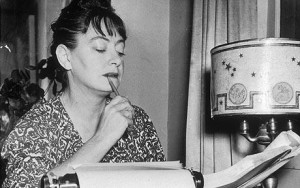 It has been a challenge and a pleasure spending time learning about Dorothy Parker and applying astrology to her life and times. In gratitude and with a sense of relief I end with another of her quotable quotes: “I hate writing, I love having written.”
It has been a challenge and a pleasure spending time learning about Dorothy Parker and applying astrology to her life and times. In gratitude and with a sense of relief I end with another of her quotable quotes: “I hate writing, I love having written.”



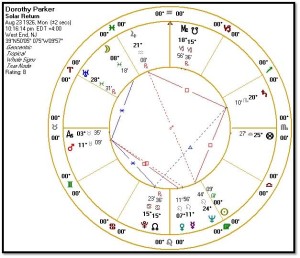
Ballistics testing that is considered as irrefutable as DNA or fingerprints today was not as highly regarded or was it as highly refined as it is today in the 1920s. In fact it wasn’t even well known in the USA until after the St. Valentines Massacre in 1929 when the guy who invented a particular method demonstrated its value by positively identifying a machine gun used to kill a particular individual in that case.
Sacco’s gun was tested using modern ballistics in 1961. It proved that, to the exclusion of all other weapons in the world, his gun was used to kill one of the people he was accused of killing. This is kind of embarrassing so “theories” of planted bullets (where? Inside the guy’s body?) and other grassy knoll type thinking popped up from the political left.
After that bit of embarassment opinion formed that was guilty and Vanzetti innocent. But in 2005 a letter written by Upton Sinclair, who championed Sacco and Vanzetti’s innocence, was discovered. In that letter he discusses a meeting with the defense attorney who admitted both men were guilty. I can’t say they received a fair trial and everyone deserves that, but the fact is they were both guilty as sin of the murders they were convicted of committing. The Wiki article on this case is just another attempted whitewash.
Parker undoubtedly got sucked in as did many others. I doubt she investigated the evidence and even if she wanted to, the 1920s were not exactly the information age we enjoy today. She took it for granted that her friends would not be involved unless the two immigrants were innocent. I wonder if her 11th house ruler, Jupiter, in detriment, connected to her ASC ruler Venus by trine helps explain this?
I am in awe of Parker’s use of language. She is undoubtedly one of the wittiest writers in American literature. She should have hung around H.L. Mencken more often. That would have been some pair. But like a lot of artistic types she was politically naive.
Sinclair’s letter is linked to below. Of particular interest is his frenzied attempts to rationalize away what he’s just been told. And this was written in 1929, 32 years before the ballistics test on Sacco’s gun. Those results might have made him faint dead away.